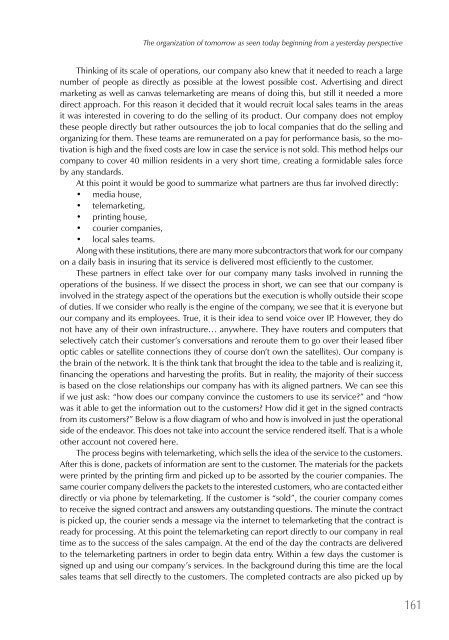Przerażony kameleon - eseje o przyszłości zarządzania - E-mentor
Przerażony kameleon - eseje o przyszłości zarządzania - E-mentor
Przerażony kameleon - eseje o przyszłości zarządzania - E-mentor
- TAGS
- kameleon
- eseje
- e-mentor.edu.pl
Create successful ePaper yourself
Turn your PDF publications into a flip-book with our unique Google optimized e-Paper software.
The organization of tomorrow as seen today beginning from a yesterday perspective<br />
Thinking of its scale of operations, our company also knew that it needed to reach a large<br />
number of people as directly as possible at the lowest possible cost. Advertising and direct<br />
marketing as well as canvas telemarketing are means of doing this, but still it needed a more<br />
direct approach. For this reason it decided that it would recruit local sales teams in the areas<br />
it was interested in covering to do the selling of its product. Our company does not employ<br />
these people directly but rather outsources the job to local companies that do the selling and<br />
organizing for them. These teams are remunerated on a pay for performance basis, so the motivation<br />
is high and the fixed costs are low in case the service is not sold. This method helps our<br />
company to cover 40 million residents in a very short time, creating a formidable sales force<br />
by any standards.<br />
At this point it would be good to summarize what partners are thus far involved directly:<br />
• media house,<br />
• telemarketing,<br />
• printing house,<br />
• courier companies,<br />
• local sales teams.<br />
Along with these institutions, there are many more subcontractors that work for our company<br />
on a daily basis in insuring that its service is delivered most efficiently to the customer.<br />
These partners in effect take over for our company many tasks involved in running the<br />
operations of the business. If we dissect the process in short, we can see that our company is<br />
involved in the strategy aspect of the operations but the execution is wholly outside their scope<br />
of duties. If we consider who really is the engine of the company, we see that it is everyone but<br />
our company and its employees. True, it is their idea to send voice over IP. However, they do<br />
not have any of their own infrastructure… anywhere. They have routers and computers that<br />
selectively catch their customer’s conversations and reroute them to go over their leased fiber<br />
optic cables or satellite connections (they of course don’t own the satellites). Our company is<br />
the brain of the network. It is the think tank that brought the idea to the table and is realizing it,<br />
financing the operations and harvesting the profits. But in reality, the majority of their success<br />
is based on the close relationships our company has with its aligned partners. We can see this<br />
if we just ask: “how does our company convince the customers to use its service?” and “how<br />
was it able to get the information out to the customers? How did it get in the signed contracts<br />
from its customers?” Below is a flow diagram of who and how is involved in just the operational<br />
side of the endeavor. This does not take into account the service rendered itself. That is a whole<br />
other account not covered here.<br />
The process begins with telemarketing, which sells the idea of the service to the customers.<br />
After this is done, packets of information are sent to the customer. The materials for the packets<br />
were printed by the printing firm and picked up to be assorted by the courier companies. The<br />
same courier company delivers the packets to the interested customers, who are contacted either<br />
directly or via phone by telemarketing. If the customer is “sold”, the courier company comes<br />
to receive the signed contract and answers any outstanding questions. The minute the contract<br />
is picked up, the courier sends a message via the internet to telemarketing that the contract is<br />
ready for processing. At this point the telemarketing can report directly to our company in real<br />
time as to the success of the sales campaign. At the end of the day the contracts are delivered<br />
to the telemarketing partners in order to begin data entry. Within a few days the customer is<br />
signed up and using our company’s services. In the background during this time are the local<br />
sales teams that sell directly to the customers. The completed contracts are also picked up by<br />
161

















